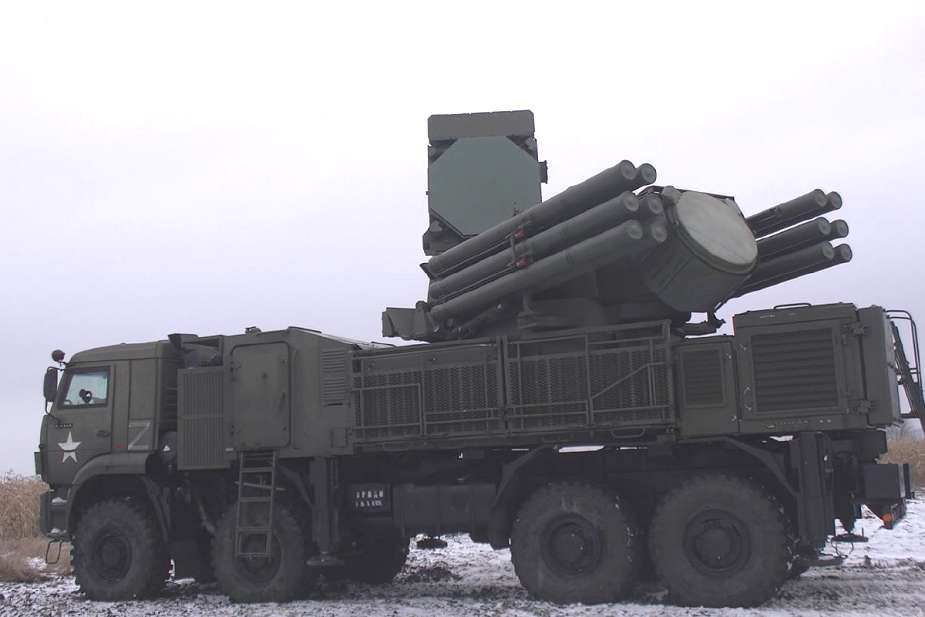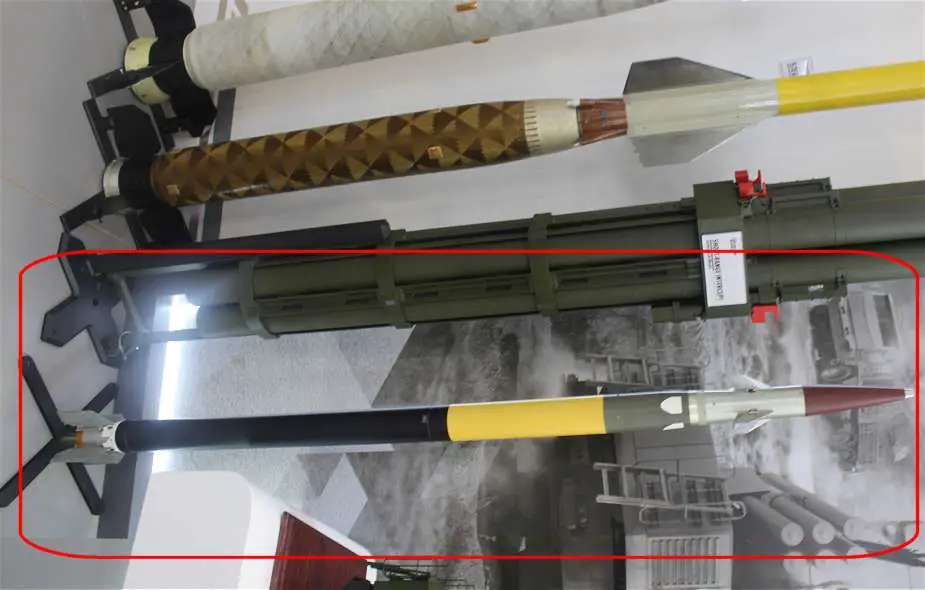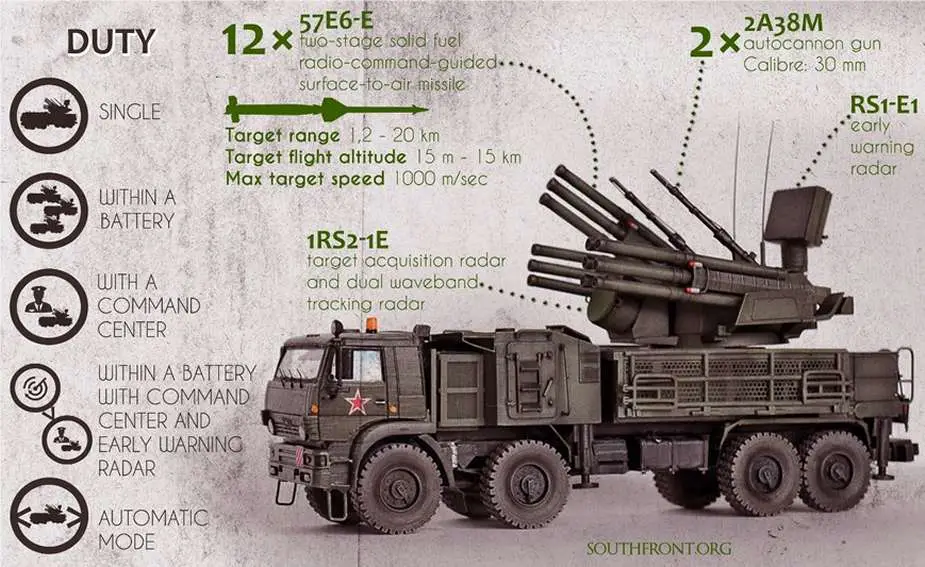As the Russian-Ukrainian Conflict unfolds, a theater where cutting-edge strategy and formidable firepower intersect, Army Recognition embarks on an ambitious journey to deliver a detailed series of articles dissecting the military hardware deployed by both Russian and Ukrainian contingents. Episode 4 shines a spotlight on the Russian Pantsir-S1 air defense system, a platform that embodies the intricate blend of lethal efficiency and advanced technological prowess that defines modern combat scenarios.
Follow Army Recognition on Google News at this link

The Pantsir-S1 air defense systems, believed to be operated by forces backed by Russia, have been reported within the conflict zones of the Russo-Ukrainian War since 2014. (Picture source Russian MoD)
This installment delves into the Pantsir-S1's dual role as both a guardian against aerial threats and a symbol of the evolving nature of warfare, where the mastery of the skies often dictates the outcome on the ground. Through an examination of its design, capabilities, and strategic deployment, we uncover how the Pantsir-S1 stands as a testament to the sophistication and complexity of contemporary military operations.
The Pantsir-S1 (NATO reporting name SA-22 Greyhound) is a sophisticated and integrated short to medium-range surface-to-air missile and anti-aircraft artillery weapon system developed by Russia. The system is designed to provide point air defense of military, industrial, and administrative installations against aircraft, helicopters, precision-guided munitions, cruise missiles, and UAVs. It also has capabilities to engage light-armored ground targets.
Development and Features
Developed by the KBP Instrument Design Bureau in Tula, Russia, the Pantsir-S1 was introduced into service with the Russian armed forces in 2012. It represents a significant evolution of Soviet-era air defense systems, combining multiple types of weapons and sensors to increase survivability and lethality on the modern battlefield.
The system typically mounts twelve 57E6 or 57E6-E two-stage solid fuel radio/optical command-guided surface-to-air missiles in sealed ready-to-launch containers. Additionally, it is equipped with two 2A38M 30 mm automatic anti-aircraft guns based on the turret of the Tunguska M1 system. These guns are capable of firing at a rate of 2,500 rounds per minute, effectively engaging targets up to 4 km away.
The Pantsir-S1 system is highly mobile, usually mounted on an 8x8 truck chassis, which allows it to move with mechanized units and to be redeployed rapidly in response to threats. Its radar system includes a target acquisition radar and a dual-band tracking radar, enabling it to track and engage multiple targets in various conditions, including in environments with heavy electronic countermeasures.

New Pantsir S1 mini-missiles at World Defense Show in Saudi Arabia in 2024 (Picture source : Army Recognition)
Russia has developed new short-range mini-missiles for the Pantsir-S1 system, specifically designed to intercept and neutralize drones and other low-flying aerial targets. These mini-missiles were unveiled at the World Defense Show in Riyadh, Saudi Arabia, highlighting a strategic focus on countering the threats posed by mass drone engagements. The mini-missiles are capable of being loaded in groups of 48 on the Pantsir launcher, a significant increase from the standard 12 units of larger missiles. This upgrade enhances the system's volume of fire and its ability to engage multiple targets simultaneously, addressing one of the key challenges in drone defense.
The mini-missiles boast high maneuverability and precision, making them suitable for close-range engagements and capable of operating in confined spaces where traditional air defense responses may be less effective. With ongoing trials expected to conclude within the year, these mini-missiles are poised to significantly enhance the Pantsir system's effectiveness against drone swarms and individual UAVs (Unmanned Aerial Vehicles), reflecting a strategic adaptation to the evolving landscape of aerial threats.
The upgrade to the Pantsir-S1M variant, which includes the integration of 48 mini-missiles, addresses past vulnerabilities by increasing the system's ammunition capacity and allowing for sustained operations against drone attacks. This development not only enhances the Pantsir system's operational effectiveness but also its strategic value in protecting military and civilian targets from aerial threats. The adaptation underscores the importance of flexible and responsive air defense capabilities in countering the diverse range of drones used in contemporary conflict zones.
Furthermore, the Pantsir-S1 system's role has been envisioned as foundational in constructing a comprehensive air defense network capable of countering any type of drone. By combining 'soft-kill' electronic countermeasures and 'hard-kill' physical destruction capabilities, the Pantsir-S1M aims to provide a multi-layered defense strategy against UAVs. This approach highlights the system's versatility in engaging aerial threats and its integration into broader tactical and strategic air defense frameworks.
In summary, the enhancements made to the Russian Pantsir-S1 air defense system, particularly with the development of mini-missiles, represent a focused effort to mitigate the threat of drones in modern warfare. As the conflict in Ukraine and other contemporary military engagements have shown, drones play a pivotal role in reconnaissance, direct attack, and psychological warfare. The upgraded Pantsir-S1 system, with its increased missile capacity and improved target engagement capabilities, positions itself as a critical asset in defending against the evolving threats posed by unmanned aerial systems.

Graphics showing the main armament of the Russian Pantsir-S1 air defense cannons/missiles system. (Picture source Linkedin)
The Pantsir-S1 air defense systems, believed to be operated by forces backed by Russia, have been reported within the conflict zones of the Russo-Ukrainian War. Evidence of the system's presence in Ukraine surfaced as early as November 2014, with its remnants observed, and further sightings in Luhansk and Makiivka among the territories held by rebels during the early months of 2015.
During the escalated confrontations of the 2022 Russian invasion of Ukraine, a Pantsir-S1 unit was immobilized in mud within the Kherson region and subsequently neutralized by Ukrainian forces. Shortly thereafter, another system was discovered abandoned in the Mykolaiv area. The conflict also saw the reported loss of a Pantsir system during combat operations around Snake Island by mid-2022. Remarkably, the Ukrainian military has claimed to have repurposed a captured Pantsir-S1, using it to down an aerial target.
Open-source intelligence platform Oryxspioenkop noted that, as of September 2023, Russia had lost at least 19 Pantsir-S1 units in the ongoing conflict. In a notable shift of deployment strategy, images emerged online in January 2023 showing Pantsir systems positioned atop the Russian Ministry of Defence and the Ministry of Education buildings in Moscow. This deployment, aimed at drone defense, marked a first for the capital city and came in the wake of several Ukrainian strikes on Russian territory, highlighting the perceived threat from drone attacks.
Further developments in 2023 indicated enhancements to the Pantsir system's software, aimed at improving its effectiveness against missiles from the US-made HIMARS rocket launcher system and the British Storm Shadow cruise missiles. These upgrades reflect ongoing adjustments to the system's capabilities in response to evolving threats.
By March 19, 2024, the Russian energy ministry disclosed initiatives to fortify oil and gas infrastructure against Ukrainian drone assaults through the implementation of defense measures including the Pantsir systems. This decision follows a series of targeted attacks on Russian energy assets, which have intensified since January, aimed at undermining Russia’s military logistics and curtailing its offensive capabilities. The strategic use of Pantsir systems in safeguarding critical energy facilities underscores their integral role in national defense, beyond conventional battlefield applications.
In the context of the ongoing conflict in Ukraine, the Russian Pantsir-S1 air defense system has undergone significant upgrades to bolster its defense capabilities, especially against drone attacks, FPV (First Person View), and loitering munitions. The enhancements are a direct response to the increasing use of drones in modern warfare, which poses a persistent threat to military assets and infrastructure.
Defense News March 2024

















